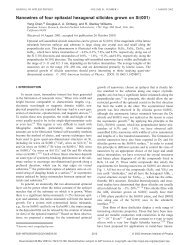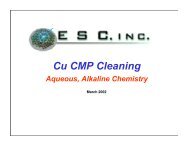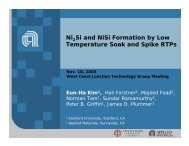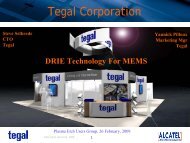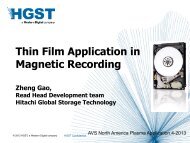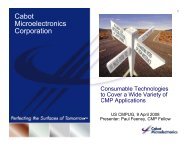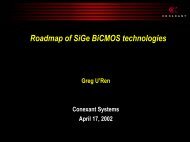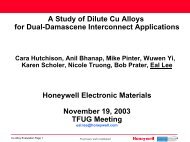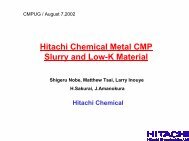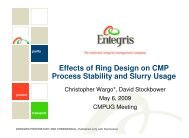Characterization and Performance of PVA Brushes for Post-CMP ...
Characterization and Performance of PVA Brushes for Post-CMP ...
Characterization and Performance of PVA Brushes for Post-CMP ...
- No tags were found...
You also want an ePaper? Increase the reach of your titles
YUMPU automatically turns print PDFs into web optimized ePapers that Google loves.
purify<strong>Characterization</strong> <strong>and</strong> <strong>Per<strong>for</strong>mance</strong> <strong>of</strong> <strong>PVA</strong> <strong>Brushes</strong><strong>for</strong> <strong>Post</strong>-<strong>CMP</strong> Cleaning <strong>of</strong> Cu Low-k FilmsprotectRakesh K. Singh, Christopher R. Wargo, David W. StockbowerLiquid Microcontamination ControlEntegris, Inc.transportENTEGRIS PROPRIETARY AND CONFIDENTIAL
Overview– <strong>Post</strong>-<strong>CMP</strong> Cleaning Technologies– Poly Vinyl Acetal (<strong>PVA</strong>) Brush Designs– <strong>Post</strong>-<strong>CMP</strong> Cleaning Process Characteristics <strong>and</strong> Trends– Mechanism <strong>of</strong> Particle Removal through Brush Scrubbing– Case Study 1 - Comparative Tribological Consistency <strong>of</strong> <strong>Brushes</strong>– Case Study 2 - <strong>Post</strong>-<strong>CMP</strong> Cleaning <strong>Per<strong>for</strong>mance</strong> <strong>of</strong> <strong>Brushes</strong>– <strong>CMP</strong> <strong>and</strong> <strong>PVA</strong> <strong>Brushes</strong> Technology Development– Summary <strong>and</strong> Conclusions<strong>PVA</strong> <strong>Brushes</strong> <strong>for</strong> P<strong>CMP</strong> Cleaning <strong>of</strong> Cu Low-k Films NCCAVS<strong>CMP</strong>UG 7/17/07, Semicon WestCONFIDENTIAL / Page 2
Common <strong>Post</strong>-<strong>CMP</strong> Cleaning Technologies:Megasonic <strong>and</strong> Double Sided Brush ScrubbingDouble Side Brush ScrubbingMegasonic Cleaning<strong>PVA</strong> <strong>Brushes</strong> <strong>for</strong> P<strong>CMP</strong> Cleaning <strong>of</strong> Cu Low-k Films NCCAVS<strong>CMP</strong>UG 7/17/07, Semicon WestCONFIDENTIAL / Page 3
Slip-on-the-core (SOTC) <strong>and</strong> Molded-throughthe-core(MTTC) <strong>PVA</strong> Brush DesignsA st<strong>and</strong>ard, hollow cylindricalsponge with nodulesMolded-through-the-core Design <strong>PVA</strong> Brush(Planarcore)Slip-on-the-core Design <strong>PVA</strong> Brush<strong>PVA</strong> <strong>Brushes</strong> <strong>for</strong> P<strong>CMP</strong> Cleaning <strong>of</strong> Cu Low-k Films NCCAVS<strong>CMP</strong>UG 7/17/07, Semicon WestCONFIDENTIAL / Page 4
Planarcore Brush Design <strong>for</strong> <strong>Post</strong>-<strong>CMP</strong> Cleaning– <strong>PVA</strong> (poly vinyl acetal) brushes used to be an industrial product be<strong>for</strong>e beingintroduced at IBM <strong>and</strong> commercialized in the early 1990’s– Entegris molded-through-the-core the (MTTC) design is a disposable <strong>PVA</strong> brushthat reduces tool downtime <strong>and</strong> provides excellent dimensional stability over itslifetime– MTTC design provides positive anchoring <strong>of</strong> <strong>PVA</strong> to the core <strong>and</strong> eliminatespossibility <strong>of</strong> any slippage at the <strong>PVA</strong>-core interface (possible in conventionalslip-on-the-core design brushes, especially in the latter part <strong>of</strong> their lifetime dueto possible swelling <strong>of</strong> <strong>PVA</strong>)– MTTC design also provides very good core flow equalization, resulting inthroughout brush lifetime consistency in the post-<strong>CMP</strong> (P<strong>CMP</strong>) cleaningper<strong>for</strong>mance<strong>PVA</strong> <strong>Brushes</strong> <strong>for</strong> P<strong>CMP</strong> Cleaning <strong>of</strong> Cu Low-k Films NCCAVS<strong>CMP</strong>UG 7/17/07, Semicon WestCONFIDENTIAL / Page 5
<strong>Post</strong>-<strong>CMP</strong> Cleaning Process Characteristics• <strong>CMP</strong> processes use abrasive slurries in the planarization process. After <strong>CMP</strong>, thewafers need to be cleaned to remove the slurry abrasive, organic residues <strong>and</strong>other particles. This P<strong>CMP</strong> cleaning is accomplished employing different tools <strong>and</strong>P<strong>CMP</strong> clean chemistries.• Advanced <strong>CMP</strong> tools have integrated P<strong>CMP</strong> modules, enabling wafer cleaning cycleto be dry in <strong>and</strong> dry out to prevent contamination.• The P<strong>CMP</strong> cleaning chemistry is typically y sprayed on top <strong>of</strong> the brush, with DIwater flowing out through the core. A combination <strong>of</strong> chemical action (provided bycleaning chemistry) <strong>and</strong> mechanical action <strong>of</strong> the rotating <strong>PVA</strong> brush removes thewafer surface deposits.• With NH4OH at pH ~10-11, <strong>PVA</strong> brush,wafer <strong>and</strong> the slurry abrasive particles,all have similar negative zeta potential.• The above results in: Repulsion between <strong>PVA</strong> <strong>and</strong> particles No particles deposit on <strong>PVA</strong> No scratches<strong>PVA</strong> <strong>Brushes</strong> <strong>for</strong> P<strong>CMP</strong> Cleaning <strong>of</strong> Cu Low-k Films NCCAVS<strong>CMP</strong>UG 7/17/07, Semicon WestCONFIDENTIAL / Page 6
Wafer Cleaning at 45 nm & Beyond –Key Attributes <strong>and</strong> Trends• Current P<strong>CMP</strong> wafer cleaning processes are contact cleaning techniques which use chemicalas well as mechanical action to effectively remove the particles from the wafer surface. In suchapplications <strong>PVA</strong> brush loading/shedding is important to monitor.• Brush cleaning is a very effective P<strong>CMP</strong> cleaning technique. In brush cleaning is the optimummode, a contact between the particle <strong>and</strong> the brush is essential to the removal <strong>of</strong> submicronsize particles from the wafer surface.• In above operation, Rm>>1 <strong>for</strong> a 0.1 micron particle, <strong>for</strong> typical brush <strong>and</strong> wafer speed, basedon an experimental study at NEU, where Rm is the ratio <strong>of</strong> removal moment to adhesivemoment, <strong>and</strong> the particles are removed if Rm>1.• In above test, 100 % particle removal could be achieved, employing intermediate brushpressure, speed <strong>and</strong> time. Studies show that brush cleaning is effective in removing particlesdown to 0.08 micron with different P<strong>CMP</strong> clean chemistries.• Non-contact megasonic cleaning is very effective in P<strong>CMP</strong> cleaning. Current <strong>and</strong> nextgeneration P<strong>CMP</strong> cleaning process will continue to depend on brush together with megasoniccleaning in the <strong>for</strong>eseeable future.[Ref: In<strong>for</strong>mation from a Surface Cleaning Tutorial at NEU]<strong>PVA</strong> <strong>Brushes</strong> <strong>for</strong> P<strong>CMP</strong> Cleaning <strong>of</strong> Cu Low-k Films NCCAVS<strong>CMP</strong>UG 7/17/07, Semicon WestCONFIDENTIAL / Page 7
Wafer Cleaning at 45 nm & Beyond –Key Attributes <strong>and</strong> Trends (Continued)• The requirements <strong>of</strong> surface cleaning must be considered while designing future generations <strong>of</strong> microchipcircuits, since 60 % <strong>of</strong> fab-related (yield) problems are related to cleans, <strong>and</strong> another 12 % to etching steps,<strong>and</strong> the design dominates how wet processing is done, <strong>and</strong> the processing limitations in turn influence thedesign process.• Many <strong>of</strong> the cleaning chemistries <strong>and</strong> approaches will have to change, <strong>and</strong> there are plenty <strong>of</strong> potentialsolutions being considered <strong>for</strong> 45 nm <strong>and</strong> beyond. Integrated Chip manufacturers will need to adopt newetch chemistries <strong>and</strong> cleaning regimens <strong>for</strong> the next generation devices.• Suggested non-damaging nanoparticle removal technologies include:– (i) Shock tube-enhanced laser-induced plasma (LIP) shockwaves <strong>for</strong> sub-50 nm nanoparticle removal,– (ii) () Plasma-assisted cleaning by electrostatics (PACE),– (iii) An ionized molecular-activated coherent solution, <strong>and</strong>– (iv) Parametric nanoscale cleaning by <strong>for</strong>ming nanoscale bubbles to absorb the contaminants.• On photoresist issues, several new or enhanced methods may be used: <strong>for</strong> minimizing silicon <strong>and</strong> oxide lossduring removal, including photoreactive cleaning (from UVTech Systems), a CO2 cryogenic press <strong>and</strong> nonoxidizingchemistry (from DuPont EKC Technology <strong>and</strong> BOC Eco-Snow Systems), <strong>and</strong> methodologies <strong>for</strong> allwetchemistries (from FSI International <strong>and</strong> SEZ Group).[Ref: In<strong>for</strong>mation from a Surface Preparation <strong>and</strong> Cleaning SEMATECH conference 2007]<strong>PVA</strong> <strong>Brushes</strong> <strong>for</strong> P<strong>CMP</strong> Cleaning <strong>of</strong> Cu Low-k Films NCCAVS<strong>CMP</strong>UG 7/17/07, Semicon WestCONFIDENTIAL / Page 8
Evolution <strong>of</strong> <strong>Post</strong>-<strong>CMP</strong> Cleaning Chemistries• <strong>Post</strong>-<strong>CMP</strong> cleans may range from extremely acidic: pH < 2 (e.g., Kanto MO2, Ashl<strong>and</strong>/AirProducts CP-70 / CP-72) to very basic with pH > 11(e.g., TMAH based) <strong>and</strong> may containsurfactants <strong>and</strong> chelating agents.• The 1st generation P<strong>CMP</strong> cleans use citric/oxalic acid solutions with low pH. These rapidlydissolved both CuO <strong>and</strong> Cu 2 O, undercutting particle or organic defects in the oxide.• Due to low pH being unfavorable <strong>for</strong> zeta potential <strong>of</strong> the substrate <strong>and</strong> particles in thesame sign, the 1 st generation chemistries need effective mechanical action such asprovided by <strong>PVA</strong> brushes.• The removal <strong>of</strong> passivating oxides using citric acid solutions may yield reactive Cu surfacerequiring BTA (benzotriazole) passivation. In general, these cleaners provided poorcleaning efficiencies.• The 2 nd generation alkaline P<strong>CMP</strong> cleans (e.g., ESC784 <strong>and</strong> ESC794 from ATMI) dissolvedCuO, while leaving Cu 2 O intact.• These cleaners high pH provide strongly negative zeta potential <strong>for</strong> the substrate as wellas particles, ensuring repulsion <strong>and</strong> eliminating particle redeposition.<strong>PVA</strong> <strong>Brushes</strong> <strong>for</strong> P<strong>CMP</strong> Cleaning <strong>of</strong> Cu Low-k Films NCCAVS<strong>CMP</strong>UG 7/17/07, Semicon WestCONFIDENTIAL / Page 9
Evolution <strong>of</strong> <strong>Post</strong>-<strong>CMP</strong> Cleaning Chemistries(Continued)• The 2 nd generation cleans require much lesser mechanical action. Also, these chemistriesgenerated less reactive Cu than the 1st generation cleaners.• Some fabs employ 3 rd generation alkaline P<strong>CMP</strong> clean solutions (e.g., ESC797D, ESC797G, SP50,<strong>and</strong> SP50A from ATMI) in Cu/Low-k processes. These provide a balance between particle &organic defect removal <strong>and</strong> surface roughness.• To reduce surface decoration <strong>and</strong> problem associated with increased surface roughness, thesecleans employ water-soluble organic solvents. These chemistries typically dissolve organicdefects <strong>and</strong> BTA-Cu complexes very efficiently.• 3 rd generation cleans reduce etch rate <strong>and</strong> surface roughness <strong>and</strong> at the same time undercut <strong>and</strong>lift the abrasive particle <strong>and</strong> organic defects left over from the <strong>CMP</strong> processing/slurries.• Due to their alkaline nature these 3 rd generation cleaning chemistries have strongly negative zetapotential, which helps in very efficient <strong>and</strong> effective particle removal.• The new trend in Cu/Low-k P<strong>CMP</strong> clean applications is to use alkaline P<strong>CMP</strong> clean chemistriesincorporating water-soluble organic solvents. Typically used in the 2nd brush box, these alkalinechemistries use a dissolution mechanism <strong>for</strong> the organic residue removal.<strong>PVA</strong> <strong>Brushes</strong> <strong>for</strong> P<strong>CMP</strong> Cleaning <strong>of</strong> Cu Low-k Films NCCAVS<strong>CMP</strong>UG 7/17/07, Semicon WestCONFIDENTIAL / Page 10
Mechanism <strong>of</strong> Particle Removal through <strong>PVA</strong>Brush Scrubbing during <strong>Post</strong>-<strong>CMP</strong> Cleaning• <strong>PVA</strong> is compressed when it contacts a particleadsorbed on the surface <strong>of</strong> the wafer• Pores <strong>and</strong> asperities on the surface <strong>of</strong> the brush:– Capture the particle– Cause the exposed surface <strong>of</strong> the particle toadsorb on the surface <strong>of</strong> the brush (eithermechanically, chemically or by capillarysuction)• Torque created by the rotation <strong>of</strong> the brushdislodges the particle from the surface• Fluid present on wafer surface, <strong>and</strong> being pumpedpin <strong>and</strong> out <strong>of</strong> brush pores (during compression <strong>and</strong>elastic recovery <strong>of</strong> the brush) carries the particleaway from the wafer500 micron<strong>PVA</strong> <strong>Brushes</strong> <strong>for</strong> P<strong>CMP</strong> Cleaning <strong>of</strong> Cu Low-k Films NCCAVS<strong>CMP</strong>UG 7/17/07, Semicon WestCONFIDENTIAL / Page 11
Case Study 1: <strong>PVA</strong> <strong>Brushes</strong> Comparative Tribological<strong>Per<strong>for</strong>mance</strong> Evaluation in Cu/Low-k Application• Factors affecting cleaning efficiency– Contact pressure at the brush <strong>PVA</strong> nodule surface <strong>and</strong> the wafer– Physical <strong>and</strong> chemical properties <strong>of</strong> cleaning fluid <strong>and</strong> its flow rate– Overall kinematics <strong>of</strong> the brush in relation to the tool– Cleaning time– Mechanical properties <strong>of</strong> the brush– Magnitude <strong>of</strong> frictional <strong>for</strong>ces between wafer <strong>and</strong> brush relative to magnitude <strong>of</strong>adhesion <strong>for</strong>ces between:• Particle <strong>and</strong> wafer• Particle <strong>and</strong> brush• Present study addresses how the extent <strong>of</strong> brush de<strong>for</strong>mation (as measured by thebrush-pressure versus brush-wafer contact-area area curves) <strong>and</strong> the magnitude <strong>of</strong>frictional <strong>for</strong>ces (as measured by the brush – fluid – wafer coefficient <strong>of</strong> friction,COF) vary as a function <strong>of</strong> extended use <strong>for</strong> various types <strong>of</strong> brushes• The above in<strong>for</strong>mation is critical in predicting brush per<strong>for</strong>mance consistency <strong>and</strong>lifetime<strong>PVA</strong> <strong>Brushes</strong> <strong>for</strong> P<strong>CMP</strong> Cleaning <strong>of</strong> Cu Low-k Films NCCAVS<strong>CMP</strong>UG 7/17/07, Semicon WestCONFIDENTIAL / Page 12
Brush Tribological Study Experimental Conditions• Constants• Variables– Applied pressure = 0.5 PSI– Cleaning solution type <strong>and</strong> flow rate =Ashl<strong>and</strong> CP – 70 at 120 cc/min– Brush <strong>and</strong> wafer rotational velocity = 60 <strong>and</strong>40 RPM, respectively– Frictional <strong>for</strong>ce data acquisition frequency =1,000 Hz (3.6 million samples / hour)– Wafer type = 200-mm International Sematech854 Copper wafer– <strong>PVA</strong> Brush Type– Brush - A• Slip-on-the-core<strong>PVA</strong> sleeve designfrom Supplier A– Brush - B• Slip-on-the-core<strong>PVA</strong> sleeve designfrom Supplier B– Brush - C– Scrubbing time = 48 Hours marathon run• Molded-through-(continuous)the-core <strong>PVA</strong>– All tested <strong>PVA</strong> brushes were similar indesign fromdimension, commercially-available <strong>and</strong> hadSupplier Ccylindrical nodules (Planarcore)<strong>PVA</strong> <strong>Brushes</strong> <strong>for</strong> P<strong>CMP</strong> Cleaning <strong>of</strong> Cu Low-k Films NCCAVS<strong>CMP</strong>UG 7/17/07, Semicon WestCONFIDENTIAL / Page 13
<strong>Brushes</strong> Tribological Test Apparatus<strong>PVA</strong> <strong>Brushes</strong> <strong>for</strong> P<strong>CMP</strong> Cleaning <strong>of</strong> Cu Low-k Films NCCAVS<strong>CMP</strong>UG 7/17/07, Semicon WestCONFIDENTIAL / Page 14
Coefficient <strong>of</strong> Friction (COF) MeasurementCOF =avgF ShearFNormal<strong>PVA</strong> <strong>Brushes</strong> <strong>for</strong> P<strong>CMP</strong> Cleaning <strong>of</strong> Cu Low-k Films NCCAVS<strong>CMP</strong>UG 7/17/07, Semicon WestCONFIDENTIAL / Page 15
Pressure Mapping ApparatusY-wiresX-wires~ 200 micronsprotective laminate filmpressure resistive sheet<strong>PVA</strong> <strong>Brushes</strong> <strong>for</strong> P<strong>CMP</strong> Cleaning <strong>of</strong> Cu Low-k Films NCCAVS<strong>CMP</strong>UG 7/17/07, Semicon WestCONFIDENTIAL / Page 16
<strong>PVA</strong> <strong>Brushes</strong> Tribological Study DataCoefficient <strong>of</strong> Friction (COF), Brush-Pressure,Contact-Area <strong>and</strong> Pressure Contour Maps<strong>PVA</strong> <strong>Brushes</strong> <strong>for</strong> P<strong>CMP</strong> Cleaning <strong>of</strong> Cu Low-k Films NCCAVS<strong>CMP</strong>UG 7/17/07, Semicon WestCONFIDENTIAL / Page 17
COF Results <strong>for</strong> Brush – A (SOTC Design)1.0COF (M Mean <strong>and</strong> Total Ran nge)0.80.60.40.20.0-0.22 4 8 24 36 48Scrubbing Time (Hour)<strong>PVA</strong> <strong>Brushes</strong> <strong>for</strong> P<strong>CMP</strong> Cleaning <strong>of</strong> Cu Low-k Films NCCAVS<strong>CMP</strong>UG 7/17/07, Semicon WestCONFIDENTIAL / Page 18
Pressure Contact-Area Relationship <strong>for</strong> Brush – A(The enveloped area bounded by the curves shows the extend <strong>of</strong> brush de<strong>for</strong>mation)Bru ush Pressur re (PSI)0.550.500.45040 0.400.350.300 hrs2hrs4 hrs8 hrs0.250.200.0 0.5 1.0 1.5 2.0 2.5Brush-Wafer Contact Area (Square Inches)<strong>PVA</strong> <strong>Brushes</strong> <strong>for</strong> P<strong>CMP</strong> Cleaning <strong>of</strong> Cu Low-k Films NCCAVS<strong>CMP</strong>UG 7/17/07, Semicon WestCONFIDENTIAL / Page 19
Pressure Contour Maps <strong>for</strong> Various applied BrushPressures <strong>for</strong> Brush - A (Time = 0 hours)PSI<strong>PVA</strong> <strong>Brushes</strong> <strong>for</strong> P<strong>CMP</strong> Cleaning <strong>of</strong> Cu Low-k Films NCCAVS<strong>CMP</strong>UG 7/17/07, Semicon WestCONFIDENTIAL / Page 20
Pressure Contour Maps <strong>for</strong> Various applied BrushPressures <strong>for</strong> Brush - A (Time = 48 hours)PSI<strong>PVA</strong> <strong>Brushes</strong> <strong>for</strong> P<strong>CMP</strong> Cleaning <strong>of</strong> Cu Low-k Films NCCAVS<strong>CMP</strong>UG 7/17/07, Semicon WestCONFIDENTIAL / Page 21
COF Results <strong>for</strong> Brush – B (SOTC Design)1.0COF (Me ean <strong>and</strong> Total Rang ge)08 0.80.60.40.20.0-0.22 4 8 24 36 48Scrubbing Time (Hour)<strong>PVA</strong> <strong>Brushes</strong> <strong>for</strong> P<strong>CMP</strong> Cleaning <strong>of</strong> Cu Low-k Films NCCAVS<strong>CMP</strong>UG 7/17/07, Semicon WestCONFIDENTIAL / Page 22
Pressure Contact-Area Relationship <strong>for</strong> Brush – B(The enveloped area bounded by the curves shows the extend <strong>of</strong> brush de<strong>for</strong>mation)Bru ush Pressur re (PSI)0.550.500.45040 0.400.350.300 hrs2 hrs4 hrs8 hrs0.250.200.0 0.5 1.0 1.5 2.0 2.5Brush-Wafer Contact Area (Square Inches)<strong>PVA</strong> <strong>Brushes</strong> <strong>for</strong> P<strong>CMP</strong> Cleaning <strong>of</strong> Cu Low-k Films NCCAVS<strong>CMP</strong>UG 7/17/07, Semicon WestCONFIDENTIAL / Page 23
Pressure Contour Maps <strong>for</strong> Various applied BrushPressures <strong>for</strong> Brush - B (Time = 0 hours)PSI<strong>PVA</strong> <strong>Brushes</strong> <strong>for</strong> P<strong>CMP</strong> Cleaning <strong>of</strong> Cu Low-k Films NCCAVS<strong>CMP</strong>UG 7/17/07, Semicon WestCONFIDENTIAL / Page 24
Pressure Contour Maps <strong>for</strong> Various applied BrushPressures <strong>for</strong> Brush - B (Time = 48 hours)PSI<strong>PVA</strong> <strong>Brushes</strong> <strong>for</strong> P<strong>CMP</strong> Cleaning <strong>of</strong> Cu Low-k Films NCCAVS<strong>CMP</strong>UG 7/17/07, Semicon WestCONFIDENTIAL / Page 25
COF Results <strong>for</strong> Brush – C (MTTC Design)1.0Total Ra nge)COF (M Mean <strong>and</strong>0.80.60.40.20.0-0.22 4 8 24 36 48Scrubbing Time (Hour)<strong>PVA</strong> <strong>Brushes</strong> <strong>for</strong> P<strong>CMP</strong> Cleaning <strong>of</strong> Cu Low-k Films NCCAVS<strong>CMP</strong>UG 7/17/07, Semicon WestCONFIDENTIAL / Page 26
Pressure Contact-Area Relationship <strong>for</strong> Brush – C(The enveloped area bounded by the curves shows the extend <strong>of</strong> brush de<strong>for</strong>mation)Bru ush Pressure e (PSI)0.550.500.45040 0.400.350.300 hrs2 hrs4 hrs8 hrs0.250.200.0 0.5 1.0 1.5 2.0 2.5Brush-Wafer Contact Area (Square Inches)<strong>PVA</strong> <strong>Brushes</strong> <strong>for</strong> P<strong>CMP</strong> Cleaning <strong>of</strong> Cu Low-k Films NCCAVS<strong>CMP</strong>UG 7/17/07, Semicon WestCONFIDENTIAL / Page 27
Pressure Contour Maps <strong>for</strong> Various applied BrushPressures <strong>for</strong> Brush - C (Time = 0 hours)<strong>PVA</strong> <strong>Brushes</strong> <strong>for</strong> P<strong>CMP</strong> Cleaning <strong>of</strong> Cu Low-k Films NCCAVS<strong>CMP</strong>UG 7/17/07, Semicon WestCONFIDENTIAL / Page 28
Pressure Contour Maps <strong>for</strong> Various applied BrushPressures <strong>for</strong> Brush - C (Time = 48 hours)<strong>PVA</strong> <strong>Brushes</strong> <strong>for</strong> P<strong>CMP</strong> Cleaning <strong>of</strong> Cu Low-k Films NCCAVS<strong>CMP</strong>UG 7/17/07, Semicon WestCONFIDENTIAL / Page 29
COF Mean <strong>and</strong> Total Fluctuation Range during 48-HourAccelerated Stress Test <strong>for</strong> <strong>Brushes</strong> A, B, <strong>and</strong> C(Mean <strong>and</strong>FluctuationCOFTotalRange)1.21.00.80.60.40.20.0-0.2MeanFluctuation RangeBrush - A0 5 10 15 20 25 30 35 40 45 50Scrubbing Time (Hour)COF (Mean <strong>and</strong>Total FluctuationRange)1.21.00.80.60.40.20.0-0.2 02MeanFluctuation RangeBrush - B0 5 10 15 20 25 30 35 40 45 50Scrubbing Time (Hour)COF (Mean<strong>and</strong>Total Fluctu uationRange)1.21.008 0.80.60.40.20.0-0.2MeanFluctuation RangeBrush - C0 5 10 15 20 25 30 35 40 45 50Scrubbing Time (Hour)<strong>PVA</strong> <strong>Brushes</strong> <strong>for</strong> P<strong>CMP</strong> Cleaning <strong>of</strong> Cu Low-k Films NCCAVS<strong>CMP</strong>UG 7/17/07, Semicon WestCONFIDENTIAL / Page 30
ObjectiveCase Study 2: <strong>PVA</strong> <strong>Brushes</strong> <strong>Post</strong>-<strong>CMP</strong> Cleaning<strong>Per<strong>for</strong>mance</strong> Evaluation in Cu/Low-k ApplicationThird Party <strong>PVA</strong> Brush <strong>Characterization</strong>To generate <strong>PVA</strong> brush post-<strong>CMP</strong> cleaning data (defect maps/classification) <strong>for</strong> ENT4, ENT5(molded-through-the-core design brushes) <strong>and</strong> a 3 rd party fab POR (slip-on-the-core design) brushin a 90 nm production fab, using 200-mm blanket <strong>and</strong> 180 nm feature MIT854 Cu/Low-k patternedwafers on a Mirra Mesa <strong>CMP</strong> tool <strong>and</strong> P<strong>CMP</strong> cleaner.Tested <strong>Brushes</strong>ENT4: St<strong>and</strong>ard <strong>for</strong>mulation <strong>PVA</strong> with molded PP coreENT5: Improved <strong>PVA</strong> with molded PP corePOR: Competitor brush used as POR at 3 rd party siteEquipment SetAMAT Mirra Mesa <strong>CMP</strong> Tool <strong>and</strong> CleanerKLA-Tencor Surfscan 6420 (blanket wafer inspection)KLA-Tencor 2139 Wafer Inspection System (<strong>for</strong> patterned wafers)KLA-Tencor SP1 (blanket wafer inspection)KLA-Tencor AIT XP Wafer Inspection System (<strong>for</strong> patterned wafers)Process conditions were optimized <strong>for</strong> current POR brush <strong>and</strong> were not specifically modified toensure good comparative data <strong>for</strong> each brush<strong>PVA</strong> <strong>Brushes</strong> <strong>for</strong> P<strong>CMP</strong> Cleaning <strong>of</strong> Cu Low-k Films NCCAVS<strong>CMP</strong>UG 7/17/07, Semicon WestCONFIDENTIAL / Page 31
AIT XP MIT854 Wafer Particle/Residue AnalysisAITxp Particle/Residue Defectsby BrushAIT XP Particle/Residue DefectsENT4 ENT5 PORMean 261.33 38.333 91Particle/Resid due325.7275.7225.7175.7125.775.725.7ENT4 ENT5 PORLot IDStdev 64.081 13.317 60.108Analysis shows improved <strong>PVA</strong> ENT5has best per<strong>for</strong>mance, but may be inthe same defect population as POR<strong>PVA</strong> <strong>Brushes</strong> <strong>for</strong> P<strong>CMP</strong> Cleaning <strong>of</strong> Cu Low-k Films NCCAVS<strong>CMP</strong>UG 7/17/07, Semicon WestCONFIDENTIAL / Page 32
Average AIT XP Pareto <strong>of</strong> Defects <strong>for</strong> 3 <strong>PVA</strong> <strong>Brushes</strong>Normal ized Defec ct Count3500300025002000150010005000MIT854 - AITxp Pareto <strong>of</strong> DefectsStd. <strong>PVA</strong><strong>for</strong>mulationImproved<strong>PVA</strong><strong>for</strong>mulationRoughness/CorrosionNo Defect Found/UnknownScratchNon-<strong>CMP</strong>Particle/ResiduePOR Total ENT4 Total ENT5 TotalBrush<strong>PVA</strong> <strong>Brushes</strong> <strong>for</strong> P<strong>CMP</strong> Cleaning <strong>of</strong> Cu Low-k Films NCCAVS<strong>CMP</strong>UG 7/17/07, Semicon WestCONFIDENTIAL / Page 33
Summary <strong>and</strong> Conclusions• Efficient <strong>Post</strong>-<strong>CMP</strong> cleaning process involves chemical as well as mechanical action. The new trend inCu/Low-k P<strong>CMP</strong> clean applications is to use alkaline P<strong>CMP</strong> clean chemistries incorporating water-solubleorganic solvents. These alkaline chemistries use a dissolution mechanism <strong>for</strong> the organic residue removal.• An accelerated tribological evaluation <strong>of</strong> three post-<strong>CMP</strong> clean <strong>PVA</strong> brushes, including two slip-on-the-coredesign (<strong>Brushes</strong> A <strong>and</strong> B) <strong>and</strong> one molded-through-the-core design (Brush - C), demonstrate a very differentbehavior <strong>of</strong> wafer-liquid-brush contact–pressure, contact–area, <strong>and</strong> dynamic coefficient <strong>of</strong> friction (COF).• Brush - A <strong>and</strong> Brush - C showed a more consistent behavior <strong>of</strong> mean COF, whereas design Brush-Bexperienced catastrophic failure somewhere between 2 <strong>and</strong> 8 hours. The total variation range <strong>of</strong> COF <strong>for</strong>Brush - C (molded-through-the-core design) seems to be minimum.• Results show that those brushes that experienced the least amount <strong>of</strong> de<strong>for</strong>mation variability during the 48-hour marathon test also exhibited the least amount <strong>of</strong> variability in their frictional attributes.• The stable behavior <strong>of</strong> brush-wafer contact-pressure, contact-area, <strong>and</strong> dynamic-friction could be usefulindicators <strong>of</strong> <strong>Post</strong>-<strong>CMP</strong> cleaning <strong>and</strong> mechanical consistency <strong>of</strong> <strong>PVA</strong> brushes over lifetime.• The post-<strong>CMP</strong> cleaning comparative per<strong>for</strong>mance evaluation <strong>of</strong> the improved <strong>PVA</strong> molded-through-the-coredesign brushes in a Cu/Low-k process was found to be similar or better than the fab POR slip-on-the-coredesign brushes in a 3 rd party characterization <strong>of</strong> <strong>PVA</strong> brushes.• This study demonstrates the importance <strong>of</strong> post-<strong>CMP</strong> clean brush design (chemically, mechanically, <strong>and</strong>dimensionally) so <strong>and</strong> methods <strong>of</strong> tribological boogca <strong>and</strong> cleaning cea per<strong>for</strong>mance evaluation auato <strong>of</strong> the <strong>PVA</strong> roller oe <strong>for</strong>ensuring consistent frictional characteristics <strong>and</strong> cleaning behavior throughout the brush lifetime.<strong>PVA</strong> <strong>Brushes</strong> <strong>for</strong> P<strong>CMP</strong> Cleaning <strong>of</strong> Cu Low-k Films NCCAVS<strong>CMP</strong>UG 7/17/07, Semicon WestCONFIDENTIAL / Page 34
<strong>CMP</strong> - Industry <strong>and</strong> Applications Trends• Changing requirements <strong>of</strong> Chemical Mechanical Planarization– More complex <strong>and</strong> dem<strong>and</strong>ing <strong>CMP</strong> solutions <strong>for</strong> 45 nm, 32 nm <strong>and</strong> smaller nodes– Introduction <strong>of</strong> larger wafers, copper, ultra low-k (ULK), high-k, <strong>and</strong> noble metals– Improved planarity <strong>and</strong> metrology specifications i in Cu/low-k, STI, <strong>and</strong> poly-si i<strong>CMP</strong>• Emerging applications, new consumables <strong>and</strong> refined processes in <strong>CMP</strong>– Each IC solution might have unique optimized <strong>CMP</strong> <strong>and</strong> P<strong>CMP</strong> clean requirements– MEMS, power devices, hard disk, SOI, GaAs, 3-Dim, photonic b<strong>and</strong>gap devices– Changed operating parameters (much lower polishing pressures in Cu/low-k <strong>CMP</strong>)– Innovative P<strong>CMP</strong> clean methods (laser, gaseous aerosols, supercritical CO 2 )• Slurry vendors, system stem suppliers <strong>and</strong> end users more interested in collaboration– Ability to evaluate <strong>and</strong> fine-tune complicated <strong>CMP</strong> slurry new <strong>for</strong>mulations quickly– Reduce CoO <strong>and</strong> minimize development/optimization time <strong>and</strong> repetition <strong>of</strong> ef<strong>for</strong>ts– Improve underst<strong>and</strong>ing <strong>of</strong> <strong>CMP</strong> process needs <strong>and</strong> share cost <strong>of</strong> development• Evaluation <strong>of</strong> <strong>CMP</strong> disruptive technologies by the end users <strong>and</strong> tool suppliers– Fixed abrasive, Electro-<strong>CMP</strong> (E<strong>CMP</strong>), <strong>and</strong> Chemically Enhanced Planarization (CEP)may <strong>of</strong>fer advantages <strong>for</strong> productivity, low stress <strong>for</strong> ULK dielectrics, <strong>and</strong> Cu loss– Reduced d need <strong>for</strong> <strong>CMP</strong> processing, P<strong>CMP</strong> cleaning, <strong>and</strong> slurry <strong>and</strong> chemical filtrationti<strong>PVA</strong> <strong>Brushes</strong> <strong>for</strong> P<strong>CMP</strong> Cleaning <strong>of</strong> Cu Low-k Films NCCAVS<strong>CMP</strong>UG 7/17/07, Semicon WestCONFIDENTIAL / Page 35
Next Generation <strong>PVA</strong> <strong>Brushes</strong> Development• Application <strong>of</strong> <strong>PVA</strong> brushes in future post-<strong>CMP</strong> cleaning processes– <strong>PVA</strong> brushes based scrubbing seems to be part <strong>of</strong> the next generation P<strong>CMP</strong> cleaning– New processes will require: low particle level <strong>PVA</strong> brushes <strong>for</strong> Cu/low-k applications <strong>and</strong> improved<strong>PVA</strong> with lower extractable levels <strong>for</strong> cleaner processes– New applications may employ charged or interminated <strong>PVA</strong> brushes <strong>for</strong> enhanced P<strong>CMP</strong> cleaning– There may be a need <strong>for</strong> IPA resistant, Cu/Low-k specific, <strong>and</strong> next generation slurry compatible<strong>PVA</strong> brush technology (surface treated <strong>PVA</strong>, contact-pressure fine-tuning, etc.)– More stringent specifications may required development <strong>of</strong> Innovative products such as moldedthrough-the-core(MTTC) brushes <strong>for</strong> better process stability• MTTC brush design (with positive adhesion/anchoring <strong>of</strong> the <strong>PVA</strong> with the core) provides ease<strong>of</strong> use, excellent dimensional stability, <strong>and</strong> improved flow equalization in the core, providinguni<strong>for</strong>m flow distribution (out-<strong>of</strong>-the-brush) along the brush length• Improved <strong>PVA</strong> quality results in reduced particle counts on the wafer, decreased defectivity,reduced tool downtime, <strong>and</strong> consistent P<strong>CMP</strong> cleaning gper<strong>for</strong>mance over brush lifetimeWhat <strong>PVA</strong> brush designs/characteristics would be needed <strong>for</strong> thenext generation post-<strong>CMP</strong> cleaning processes ? Your feedback!<strong>PVA</strong> <strong>Brushes</strong> <strong>for</strong> P<strong>CMP</strong> Cleaning <strong>of</strong> Cu Low-k Films NCCAVS<strong>CMP</strong>UG 7/17/07, Semicon WestCONFIDENTIAL / Page 36
Acknowledgments– NCCAVS <strong>CMP</strong>UG committee <strong>for</strong> the opportunity to present at this meeting– Dr. Ara Philipossian <strong>for</strong> in<strong>for</strong>mation from Univ <strong>of</strong> Arizona Tribological Studies– Dr. Ashwani Rawat, Dr. Robert Donis <strong>and</strong> Dr. Peter Burke <strong>for</strong> helpful insights– Liquid Microcontaminations Control Team at Entegris, Inc., <strong>for</strong> their supportEntegris Corporate Pr<strong>of</strong>ile•Company founded as Flouroware in 1966 • Merged with Mykrolis in August 2005 •Corporate headquarters in Chaska (Minneapolis), Minnesota • 2,700 employees worldwide• Key manufacturing, sales <strong>and</strong> service facilities in the U.S., France, Germany, Malaysia,Singapore, Taiwan, China, South Korea <strong>and</strong> Japan • Delivers microcontamination controlproduct <strong>and</strong> service solutions to the semiconductor industry (three-quarters <strong>of</strong> thecompanies sales) <strong>and</strong> other industries including data storage<strong>PVA</strong> <strong>Brushes</strong> <strong>for</strong> P<strong>CMP</strong> Cleaning <strong>of</strong> Cu Low-k Films NCCAVS<strong>CMP</strong>UG 7/17/07, Semicon WestCONFIDENTIAL / Page 37



